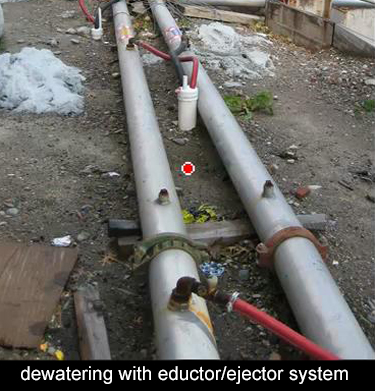We are at the same excavation for the building foundation. I want to speak for a minute on dewatering. Whenever you do an excavation, it's likely to attract and collect a certain amount of water, which has to be pumped away. Very often, that's a simple procedure. You might just slope the bottom of your trench and have it all collect at a low point.
You might excavate a small local sump to catch the water and assist you in pumping it out from time to time. But here in a major excavation, which is taking place below the water table, you need to dewater the site on a continuous basis, and the water is pumped out of this site, 24/7. There are several methods for doing this. I'm just going to briefly outline some of the most popular ones just to give you a little feeling for what this is about.
At this point, there's a deep well which has been installed and, within that well, there is a submersible pump. The pump discharges the water into a header and the header removes the water from the site. This process is repeated at regular intervals. This process is called Deep Wells. Deep Wells move a tremendous amount of water and can lower the water table significantly.
One of the drawbacks is the cost of operating a deep well system on a construction site, if you use a pump, it must be manned by somebody - a pump man or a pump operator and a pump operator can operate several pumps, but beyond a certain limit, which might be four to six pumps, you would need a second pump operator. Now on this site, there are many, many pumps, and it would probably require multiple pump operators being paid around the clock, 24/7. If you do the math and include all the overtime, you'll see that that is a huge expense. However, if the project demands it, then that cost has to be built into the cost of construction.
 This illustrates a different system. This is an ejector system or an inductor system. This is one of the wells and this works on a different principle. High pressure water is pumped in. It is pumped down to the bottom of the well, where it goes through a nozzle, which creates a Venturi effect, which creates, a drop in pressure, and it actually draws water out of the ground.
This illustrates a different system. This is an ejector system or an inductor system. This is one of the wells and this works on a different principle. High pressure water is pumped in. It is pumped down to the bottom of the well, where it goes through a nozzle, which creates a Venturi effect, which creates, a drop in pressure, and it actually draws water out of the ground.
You get high pressure water going in. You get the spent water coming out, but you're removing more water than you're pumping in. The net amount is dewatering the site. Some of the differences here, you can see the wells are much more closely spaced. The great advantage is that only a single pump does all of the pumping. There's just a single person manning the pumps.
This is a blow-up of the same setup. To avoid any confusion the headers are carefully labeled. This is high pressure water in. And this is the return flow. The return flow is greater than the amount of water entering the system.
 Finally, this is a very basic dewatering system. There's a header which is a suction header and there are many well points. The well points are very closely spaced and they can only lower the water table a limited amount. This photo is in Florida, where the water table is very high and has to be lowered just a small amount to facilitate the construction of the foundation.
Finally, this is a very basic dewatering system. There's a header which is a suction header and there are many well points. The well points are very closely spaced and they can only lower the water table a limited amount. This photo is in Florida, where the water table is very high and has to be lowered just a small amount to facilitate the construction of the foundation.
I would like to summarize the material we've covered so far. The first device we looked at is called a trench box. And this is a very simple device which gives you excellent protection. But some of the drawbacks are you need a great deal of open space and the space has to be free of any utilities.
More commonly used is a system of timber sheeting. It's a very flexible system because it can take any shape. It's constructed with small, easy to handle material and it can conform to an accommodate existing utilities.
When the excavation is too deep or too wide for timber sheeting, you need to go to more robust material and the system that you typically would consider would be soldier piles and lagging. Now, you have steel members, you can go down deeper. You can brace a much wider trench and this system also can accommodate utilities. This is an extremely versatile and valuable system.
When you're operating below the water table, you need to continuously dewater the excavation to keep it dry. you need to use steel sheet piling where the steel sheets are interlocked to keep the water out. As you can see in this photo, they are driven in a sort of progressive way - not driven all at once.
Finally, when you're in a building excavation, you use a system of inclined rakers, or you will often use this system. These rakers are braced back to the previously poured foundation slab. The braces are systematically removed as the foundation slab and walls progress.